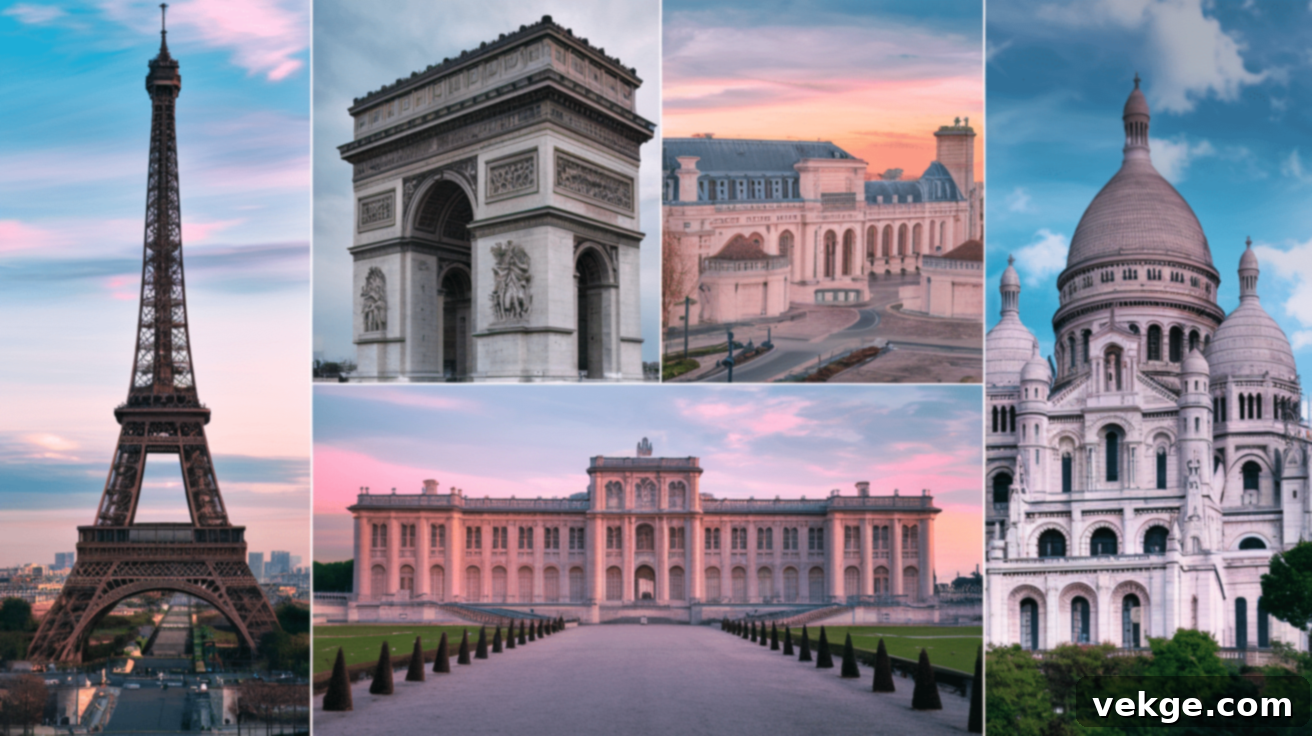Discover France’s Enduring Legacy: A Deep Dive into Its Most Iconic Historical Monuments
Step onto the ancient cobblestones of France, and you’ll find yourself instantly transported through centuries of history. Every quiet street, every towering spire, and every grand hall whispers tales of empires, revolutions, artistic brilliance, and the daily lives of countless individuals. These aren’t merely old structures made of stone and glass; they are vibrant pieces of history, imbued with the spirit of the people and events that shaped them, offering a profound connection to the past.
This comprehensive guide invites you on an immersive journey to explore some of France’s most celebrated and iconic landmarks. We will uncover what makes each site truly special, delving into the historical narratives that transformed them from mere buildings into symbols of national identity and global heritage. From the grand ambitions of kings and the innovative minds of artists to the resilience of everyday citizens, each location has a compelling story to tell, reflecting the complex tapestry of French history.
You don’t need to be a seasoned historian to appreciate these magnificent sites. Our aim is to provide an accessible and engaging overview, allowing you to grasp how these architectural wonders not only influenced the development of the nation but continue to hold deep meaning and significance in the modern world. Prepare to be inspired by the enduring legacy of France, as seen through its most remarkable historical monuments.
Explore France’s Most Famous and Iconic Landmarks
Join us as we take a closer look at some of the most renowned and deeply symbolic landmarks across France, each a testament to the nation’s rich and multifaceted past.
1. The Eiffel Tower: Paris’s Iron Lady

Conceived by the brilliant engineer Gustave Eiffel, the Eiffel Tower was constructed for the 1889 World’s Fair, an event commemorating the 100th anniversary of the French Revolution. This monumental feat of engineering, standing proudly at 324 meters (1,063 feet) tall, claimed the title of the world’s tallest structure for over four decades, until 1930.
Initially, the tower was intended to be a temporary installation, slated for demolition after just 20 years. However, its unforeseen strategic value for radio communication became its salvation, protecting it from being dismantled. Despite facing initial resistance and being branded an “eyesore” by many artists and intellectuals who signed petitions against its construction, it quickly became a beloved symbol of France.
Today, the Eiffel Tower remains a beacon of Parisian allure, captivating visitors with its nightly sparkling light shows, which utilize an astonishing 20,000 lightbulbs. Its maintenance is an ongoing endeavor, requiring approximately 60 tons of paint every seven years to preserve its iconic appearance. With three distinct visitor levels, offering breathtaking panoramic views of Paris, the tower has welcomed an astounding 300 million visitors since its inauguration, solidifying its place as one of the world’s most visited paid monuments.
2. Arc de Triomphe: A Monument to French Valor
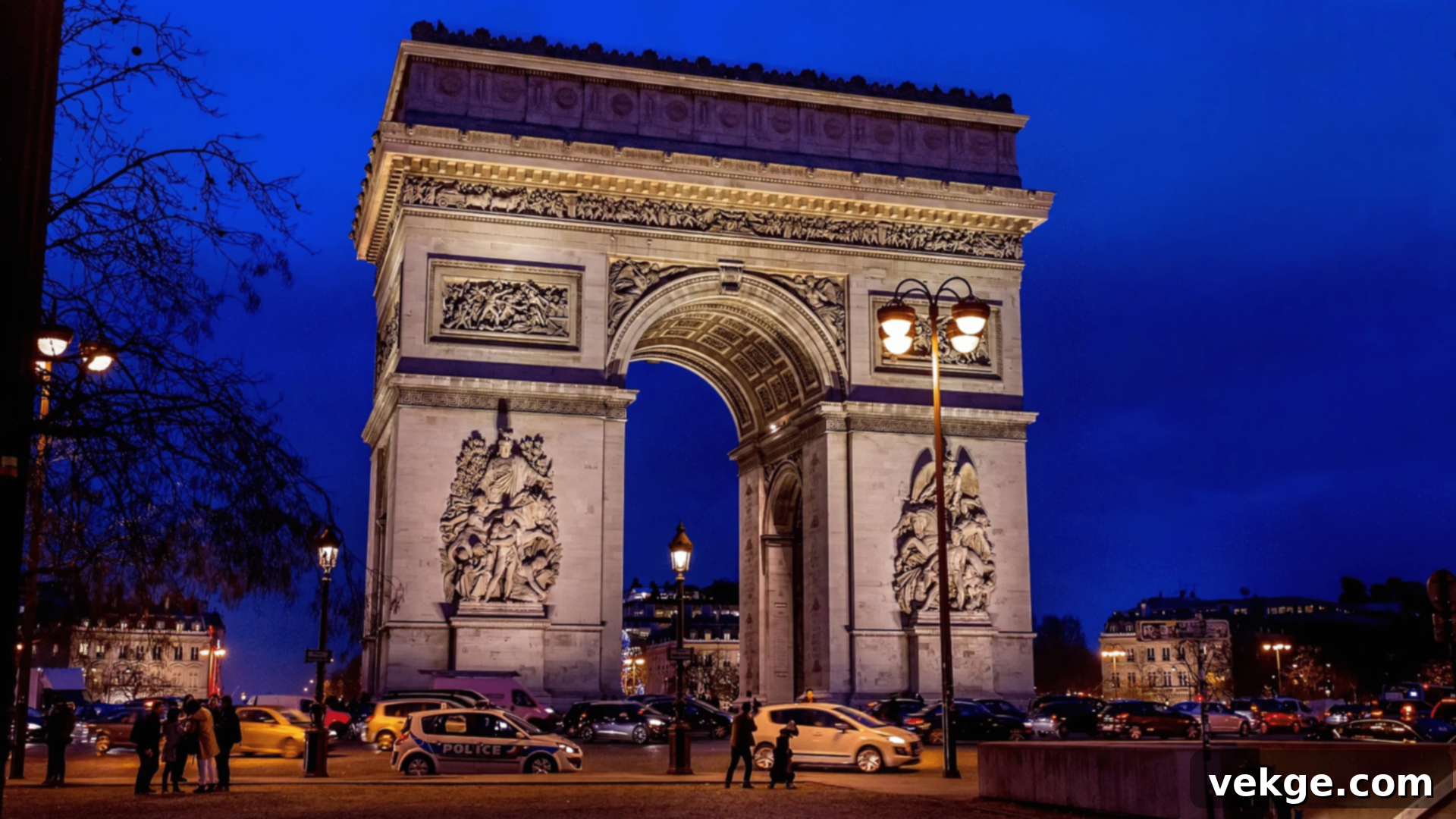
Commissioned by Napoleon Bonaparte in 1806 following his resounding victory at the Battle of Austerlitz, the Arc de Triomphe was intended to honor the triumphs of the French army. However, its construction faced significant delays and even halted during periods of French military setbacks, especially after Napoleon’s fall from power.
It was ultimately completed much later, in 1836, under the reign of King Louis-Philippe, long after Napoleon’s death. This colossal arch, measuring 50 meters (164 feet) high and 45 meters (148 feet) wide, quickly became the central gathering point for both celebratory victory parades and poignant protest marches throughout pivotal moments in French history. It witnessed the somber march of German troops in 1871 and 1940, and the triumphant passage of Allied forces liberating Paris in 1944.
Since 1921, the Arc de Triomphe has served as the revered home of the Tomb of the Unknown Soldier, beneath which an eternal flame burns brightly, honoring the unidentified fallen soldiers of both World Wars. Visitors can ascend 284 steps to the monument’s summit, where they are rewarded with a spectacular view of the 12 grand avenues radiating outwards from the arch, forming a perfect star-shaped pattern across the urban landscape.
3. Mont Saint-Michel: Abbey in the Sea
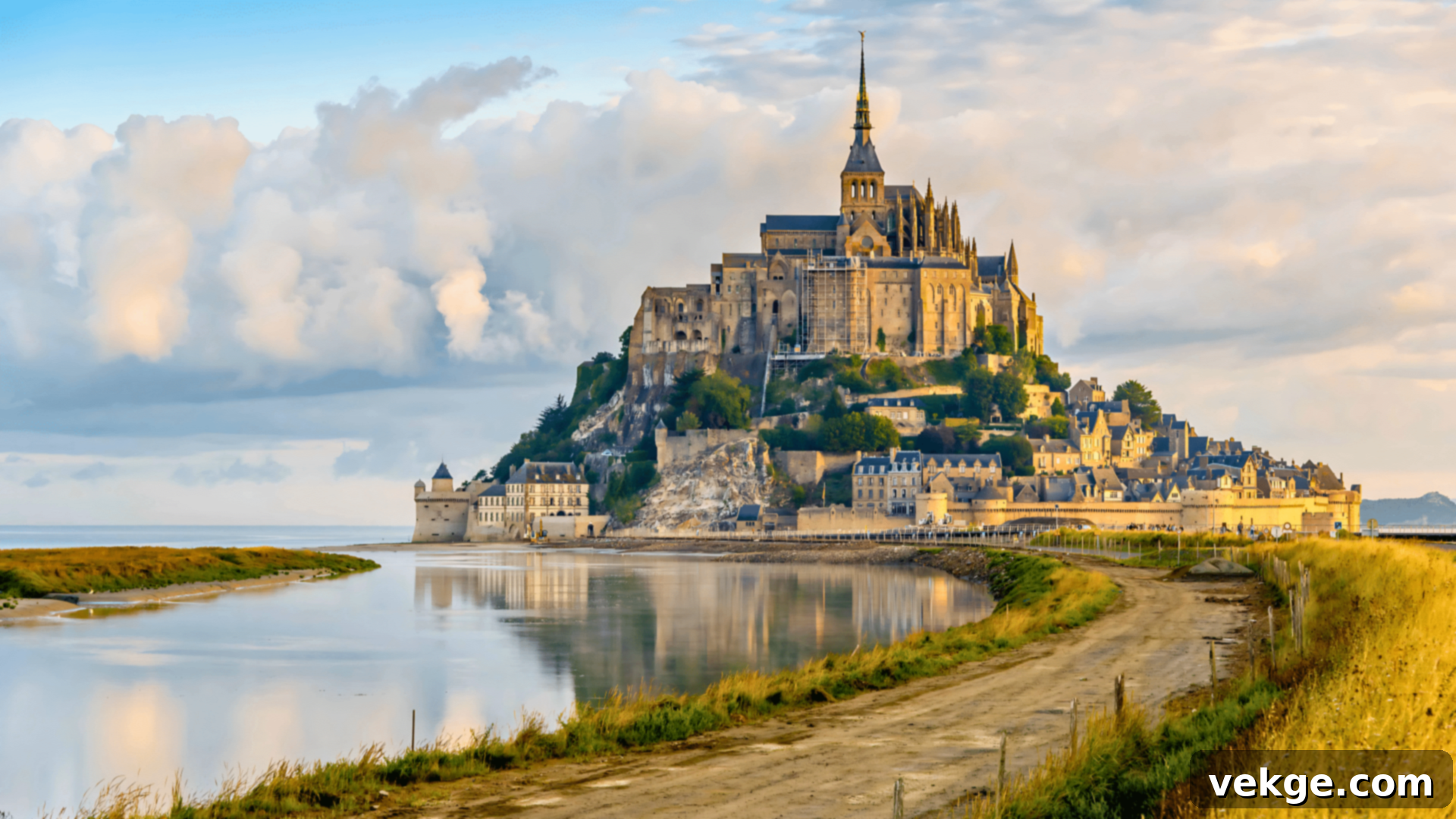
The remarkable history of Mont Saint-Michel began in 708 AD when Bishop Aubert of Avranches, inspired by a reported vision of the Archangel Michael, established a small sanctuary on this isolated tidal island. Over succeeding centuries, Benedictine monks meticulously constructed the magnificent abbey high on the rocky outcrop, with the monastery’s complex structure largely completed by the 16th century, showcasing a blend of Romanesque and Gothic architectural styles.
During the tumultuous Hundred Years’ War, the island fortress proved impregnable, successfully repelling repeated English attempts to capture it. It stood as one of the few places in France to staunchly resist English domination. Later, during the French Revolution, the abbey’s sacred purpose was drastically altered as it was converted into a prison, earning it the grim nickname “Bastille of the Sea.” Its eventual restoration as a historical monument was ordered by Napoleon III in 1863.
Mont Saint-Michel’s unique coastal location is defined by some of Europe’s most dramatic tides, reaching an astonishing 46 feet (14 meters). Several times a month, the island is completely encircled by water, transforming it into an ethereal, isolated marvel, a truly unforgettable sight for its millions of annual visitors.
4. Notre-Dame Cathedral: A Gothic Masterpiece Enduring Time
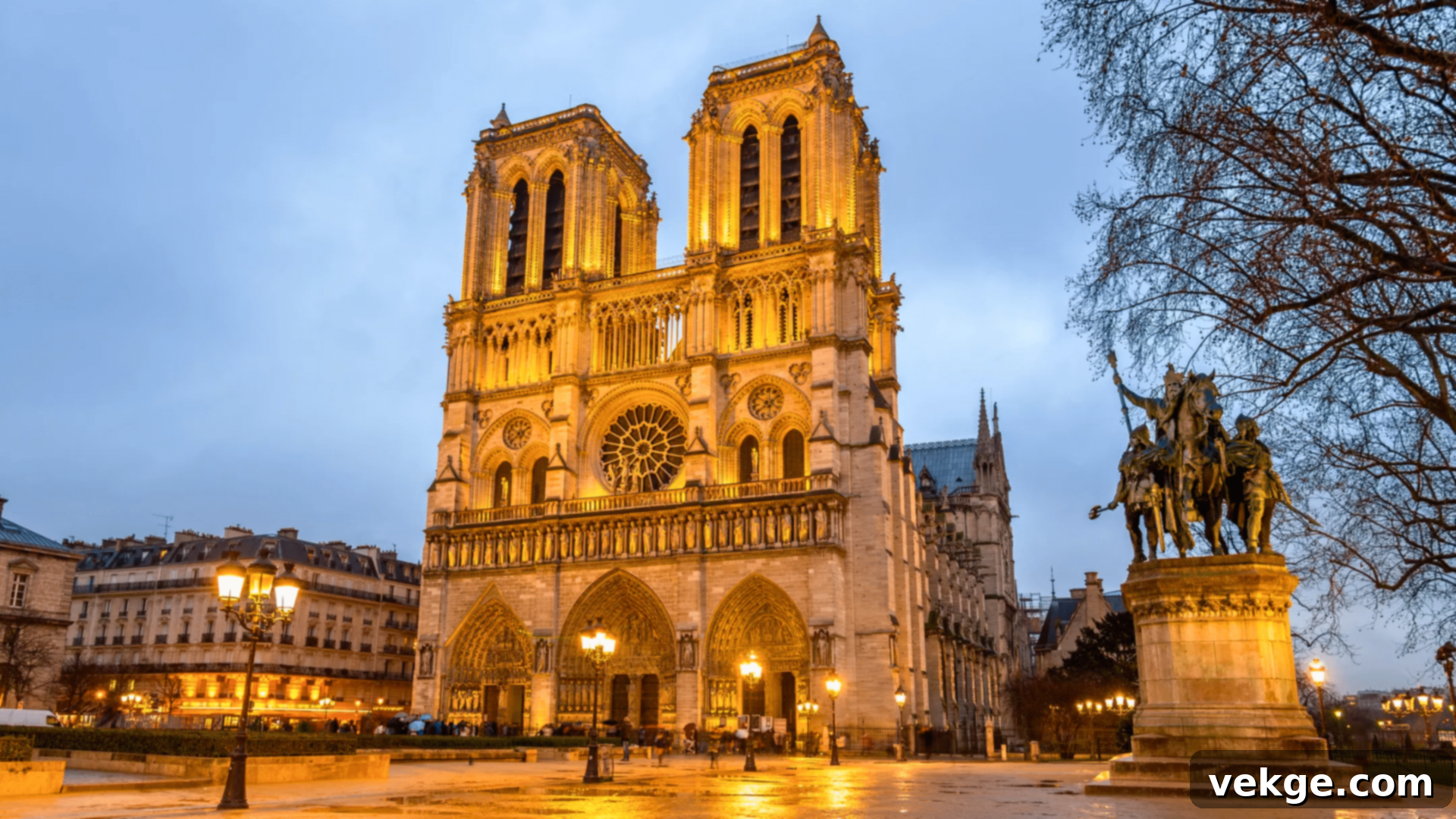
The construction of the illustrious Notre-Dame Cathedral commenced in 1163 under the patronage of Bishop Maurice de Sully, a monumental undertaking that spanned nearly 200 years to reach its initial completion. This iconic cathedral stands as a quintessential example of French Gothic architecture, celebrated for its innovative flying buttresses, immense and vibrant rose windows, and the iconic, often grotesque, chimera gargoyles that adorn its facade.
Throughout its long history, Notre-Dame has miraculously survived numerous threats. It was stripped of many treasures during the iconoclastic fervor of the French Revolution, narrowly escaped demolition in the 19th century, and sustained damage during both World Wars. Public interest in its preservation and repair was significantly rekindled by Victor Hugo’s influential 1831 novel, “The Hunchback of Notre-Dame.”
The devastating fire of April 2019 tragically destroyed its iconic spire and much of the roof, sending shockwaves across the globe. However, remarkably, most of its priceless art and sacred relics were bravely rescued. An immense global effort and over €1 billion in donations have fueled its ambitious rebuilding project, with the aim of reopening this beloved spiritual and architectural treasure by 2024, continuing its eternal story.
5. Palace of Versailles: Epitome of Royal Grandeur
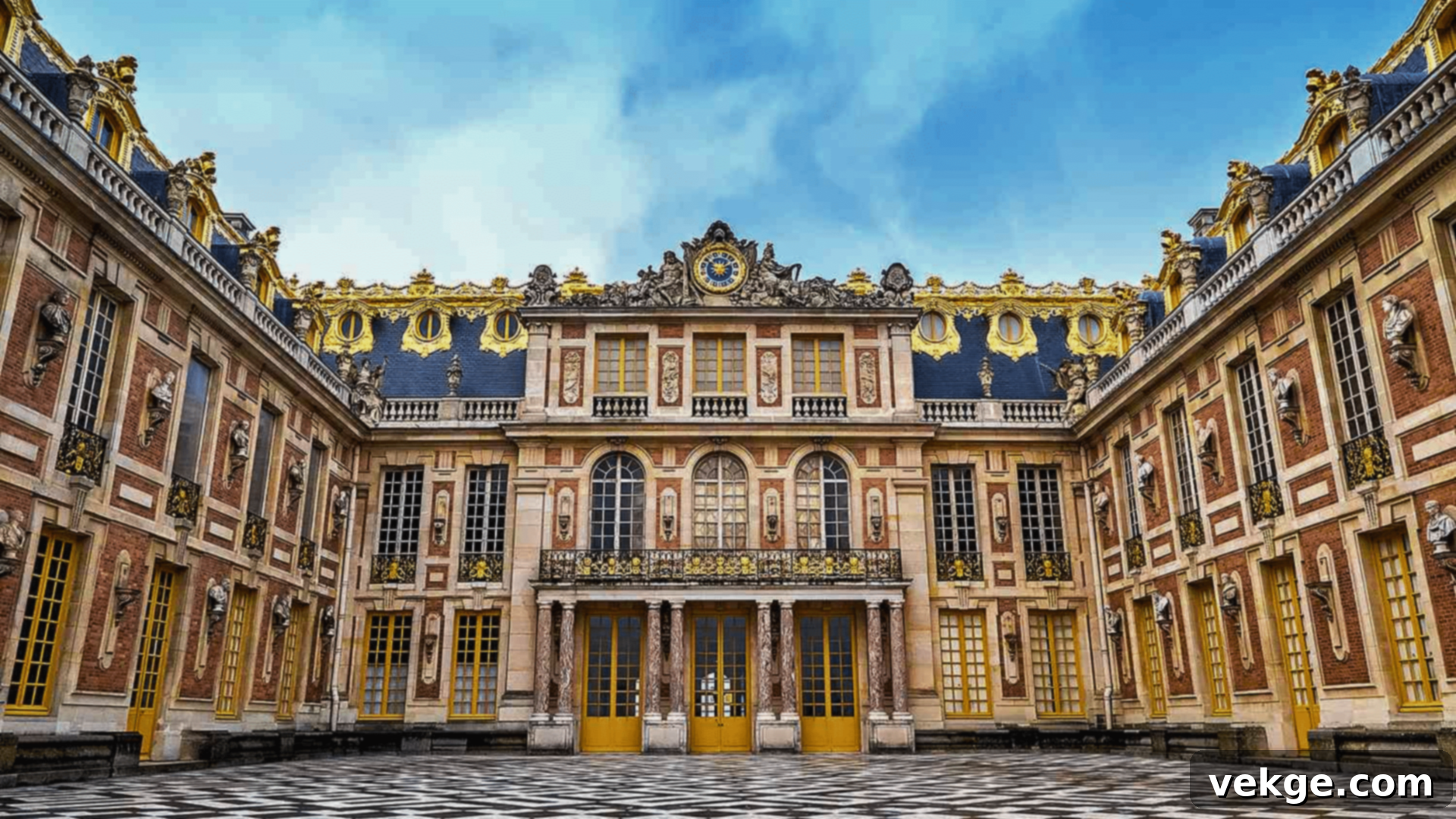
What began as a relatively modest hunting lodge built by Louis XIII in 1623 was spectacularly transformed by his successor, Louis XIV, into the opulent Palace of Versailles. Between 1661 and 1710, the “Sun King” meticulously oversaw its expansion and embellishment, turning it into an unparalleled symbol of absolute monarchy. In 1682, he moved his entire court and the seat of government there, effectively making Versailles the political and cultural capital of France.
The palace has been a silent witness to some of history’s most pivotal events, including the signing of the 1783 Treaty of Paris, which officially concluded the American Revolutionary War. During the tumultuous French Revolution, angry Parisian crowds marched to Versailles, compelling Louis XVI and Marie Antoinette to return to Paris, marking the end of the monarchy’s lavish era at the palace. Later, the breathtaking Hall of Mirrors became the solemn setting for the signing of the 1919 Treaty of Versailles, formally ending World War I.
Today, the sprawling estate boasts an astonishing 2,300 rooms, adorned with 5,000 pieces of furniture and 6,000 paintings. Its meticulously manicured gardens are equally impressive, featuring 372 statues and 55 magnificent fountains, making Versailles an enduring testament to French artistic and political power.
6. Louvre Museum: A Fortress Transformed into an Artistic Haven

The Louvre’s origins trace back to 1190, when it was initially constructed as a formidable defensive fortress under the reign of King Philippe Auguste, designed to protect Paris from invaders. As the city expanded and its defensive needs evolved, the fortress gradually lost its military function. In the 16th century, François I began its transformation into a magnificent royal residence, setting the stage for its future as a cultural icon.
Each successive monarch contributed to its grandeur, adding wings and expanding its collections, until Louis XIV famously relocated the royal court to Versailles. During the fervent years of the French Revolution, the Louvre was declared a public museum in 1793, opening its doors to display an initial collection of 537 paintings for the common people.
Napoleon Bonaparte significantly augmented its collection, filling its halls with art treasures acquired during his military campaigns across Europe. Today, the museum encompasses a vast area of 72,735 square meters (782,910 sq ft), housing an extraordinary 380,000 objects, with approximately 35,000 works of art permanently on display. I. M. Pei’s controversial yet iconic glass pyramid entrance, completed in 1989, has become a striking symbol of the Louvre, brilliantly blending modern architectural innovation with the timeless classical beauty of the historic palace.
7. Sacré-Cœur Basilica: A White Jewel on Montmartre
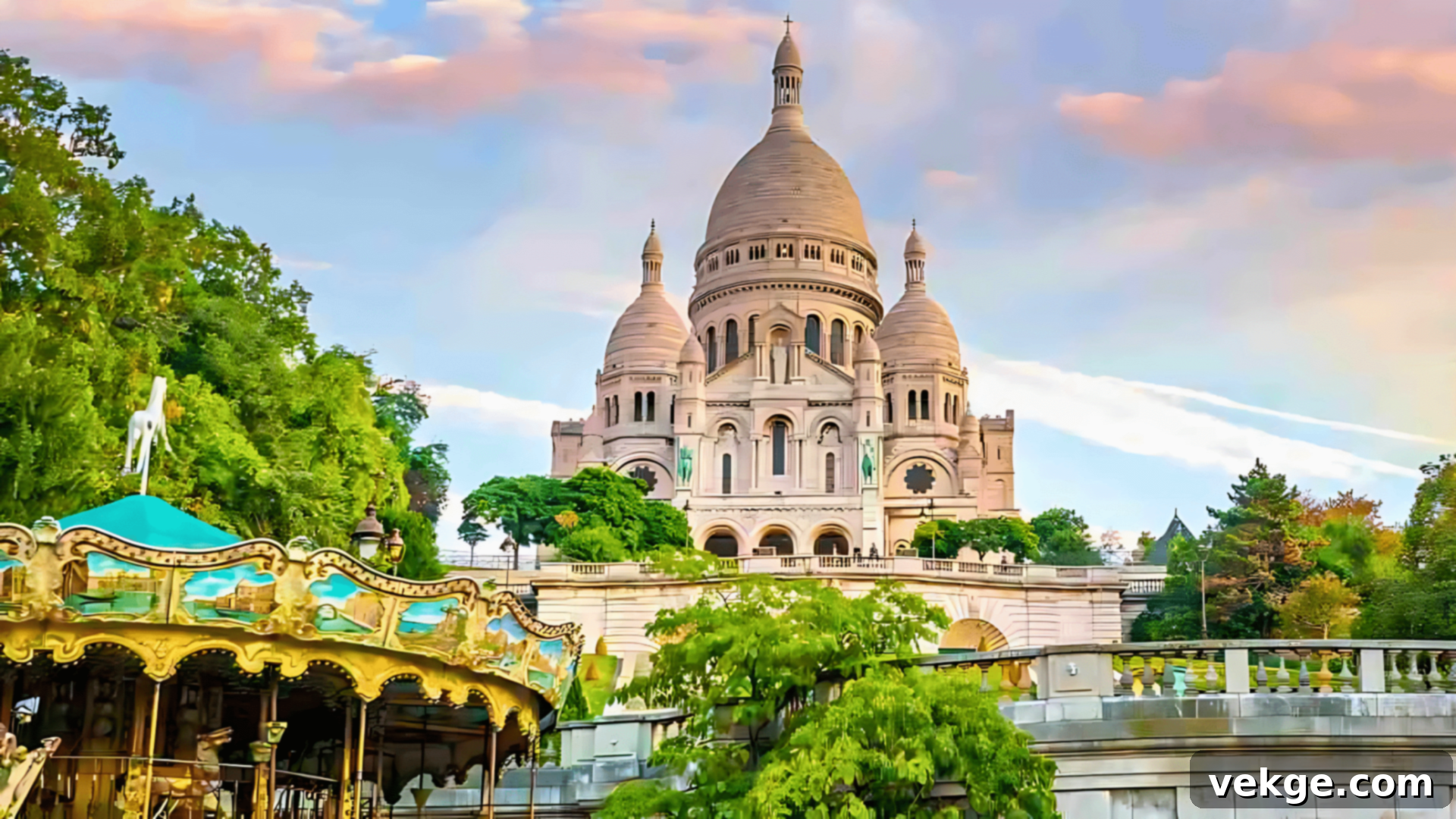
Perched majestically atop the Montmartre hill, the Sacré-Cœur Basilica was constructed between 1875 and 1914 as a national vow and act of penance for the perceived moral decline and spiritual suffering that contributed to France’s defeat in the Franco-Prussian War and the brutal events of the Paris Commune uprising. Its distinctive Roman-Byzantine architectural style, a departure from the prevalent Gothic tradition in French churches, makes it stand out dramatically against the Parisian skyline.
One of its most unique features is the brilliant white travertine stone sourced from Château-Landon, which contains calcite. This natural property ensures that when it rains, the stone releases a bleaching agent, remarkably keeping the basilica’s facade pristine and white despite urban pollution. Situated on the 130-meter (426-foot) high Montmartre, its grand dome is visible from nearly every corner of Paris, offering unparalleled panoramic views of the city below.
Inside, the basilica houses one of the world’s heaviest bells, the “Savoyarde,” weighing a staggering 19 tons. Despite its relatively recent construction compared to other Parisian landmarks, the Sacré-Cœur has swiftly become one of the city’s most beloved and visited sites, cherished for both its profound religious significance and its spectacular vantage point.
8. Château de Chambord: A Renaissance Masterpiece in the Loire Valley

King François I commissioned the construction of Château de Chambord in 1519, intending it to be a vast hunting lodge and a powerful display of his wealth and prestige. While officially categorized as a “hunting lodge,” its sheer scale—boasting an astonishing 440 rooms, 84 staircases, and 365 fireplaces (one for each day of the year)—unmistakably reveals its true purpose as a magnificent statement of royal might and Renaissance architectural ambition. Despite its grandeur, François I himself spent a mere 72 days there throughout his entire reign.
The castle’s most celebrated and enigmatic feature is its double-helix staircase, a design marvel that allows two people to ascend and descend simultaneously without ever meeting. This ingenious design is often attributed to the polymath Leonardo da Vinci, who spent his final years as a guest of King François I, living nearby.
During World War II, the château played a crucial, clandestine role as a secure hiding place for invaluable art pieces from the Louvre Museum, protecting them from Nazi looting. Today, the castle is nestled within Europe’s largest enclosed forest park, spanning an impressive 5,440 hectares (13,442 acres) and encircled by a vast 32-kilometer (20-mile) wall, making it a truly immersive historical and natural experience.
9. Pont du Gard: Roman Engineering at its Finest
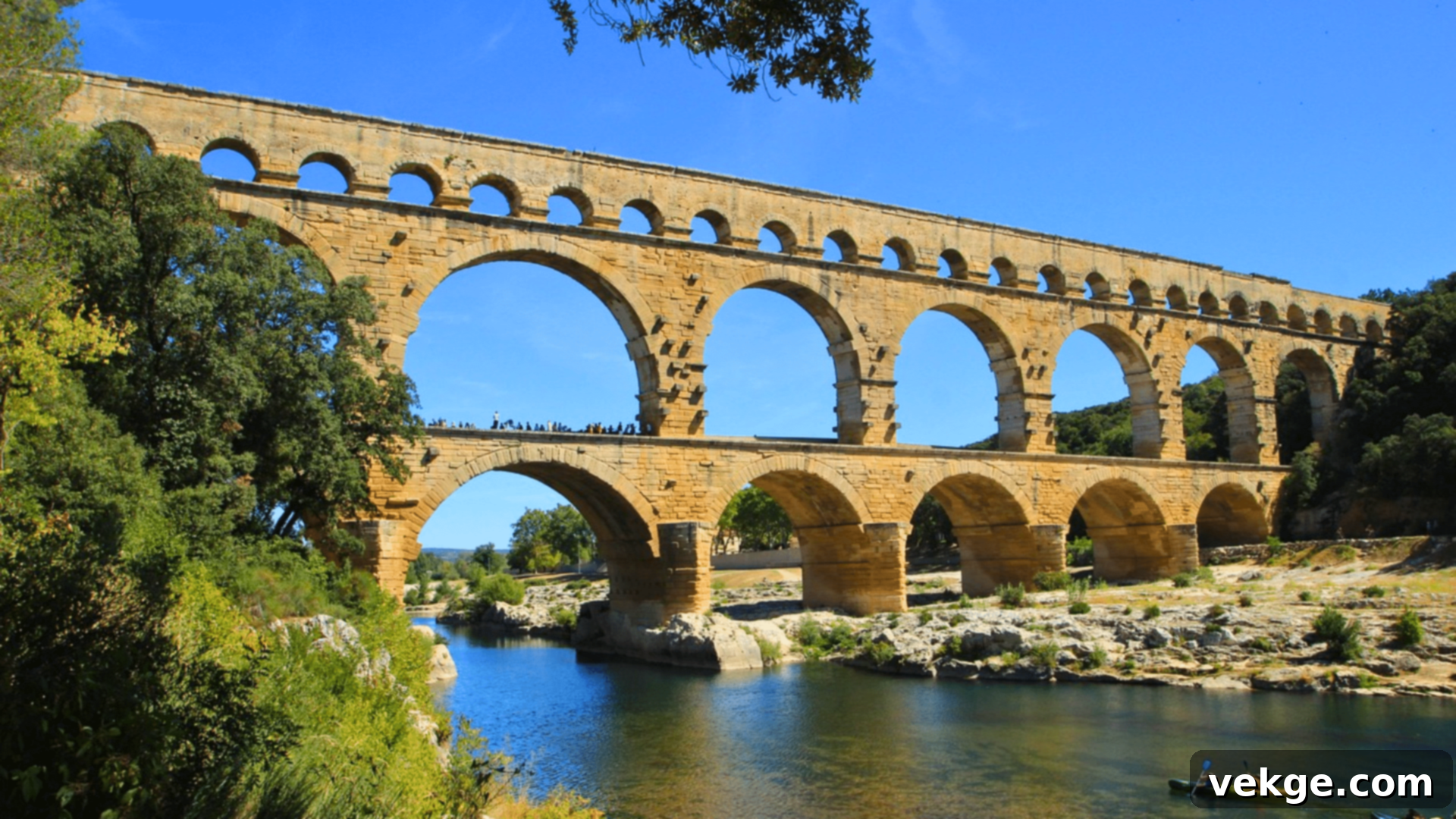
A breathtaking testament to Roman ingenuity, the Pont du Gard is a three-tiered aqueduct bridge constructed around 40-60 AD. Its primary purpose was to transport water from the natural springs near Uzès over a distance of 50 kilometers (31 miles) to the thriving Roman colony of Nemausus (modern-day Nîmes), ensuring a steady supply for its growing population and public baths.
Standing an impressive 49 meters (160 feet) high, it holds the distinction of being the tallest of all surviving Roman aqueduct bridges. The Roman engineers behind its creation employed incredibly precise construction techniques, utilizing a remarkably shallow gradient of just 1 in 3,000 to maintain the consistent flow of water. Astonishingly, no mortar was used in its primary construction; instead, 50,000 tons of meticulously cut stones were interlocked with extraordinary precision, secured by iron clamps, forming a structure of unparalleled durability. The intricate water channel once transported an estimated 44 million gallons of water daily.
After the decline of the Roman Empire, locals ingeniously repurposed the aqueduct as a toll bridge. Its survival over two millennia can be attributed partly to its sheer, massive construction, which made dismantling it an almost impossible task, and partly to its early protection by some of France’s first preservation laws in the 18th century, ensuring its legacy for generations to come.
10. Carcassonne: A Medieval Fortified City

The history of the fortified city of Carcassonne is an epic saga spanning over 2,500 years, with archaeological evidence pointing to human settlement dating as far back as 3500 BC. Its strategic location, nestled between the Atlantic Ocean and the Mediterranean Sea, made it a highly prized and contested stronghold throughout various historical periods.
The Romans were the first to fortify the site around 100 BC, and their defensive structures were further expanded and strengthened by the Visigoths in the 5th century. Carcassonne’s most distinctive feature is its impressive double ring of walls, stretching for 3 kilometers (1.9 miles) and punctuated by 52 formidable towers, all meticulously designed to withstand prolonged sieges.
After the Kingdom of France annexed the region in 1247, Carcassonne became a vital border fortress guarding against Spain. It eventually fell into disrepair until the celebrated architect Eugène Viollet-le-Duc spearheaded a controversial restoration project in the 19th century. His additions, particularly the pointed roofs on the towers, drew criticism for appearing too “fairy tale-like” and historically inaccurate. Nevertheless, Carcassonne remains one of France’s most complete and dramatically preserved medieval fortified cities, attracting over 3 million visitors annually who come to marvel at its timeless beauty and immerse themselves in its rich past.
11. Sainte-Chapelle: A Jewel Box of Stained Glass
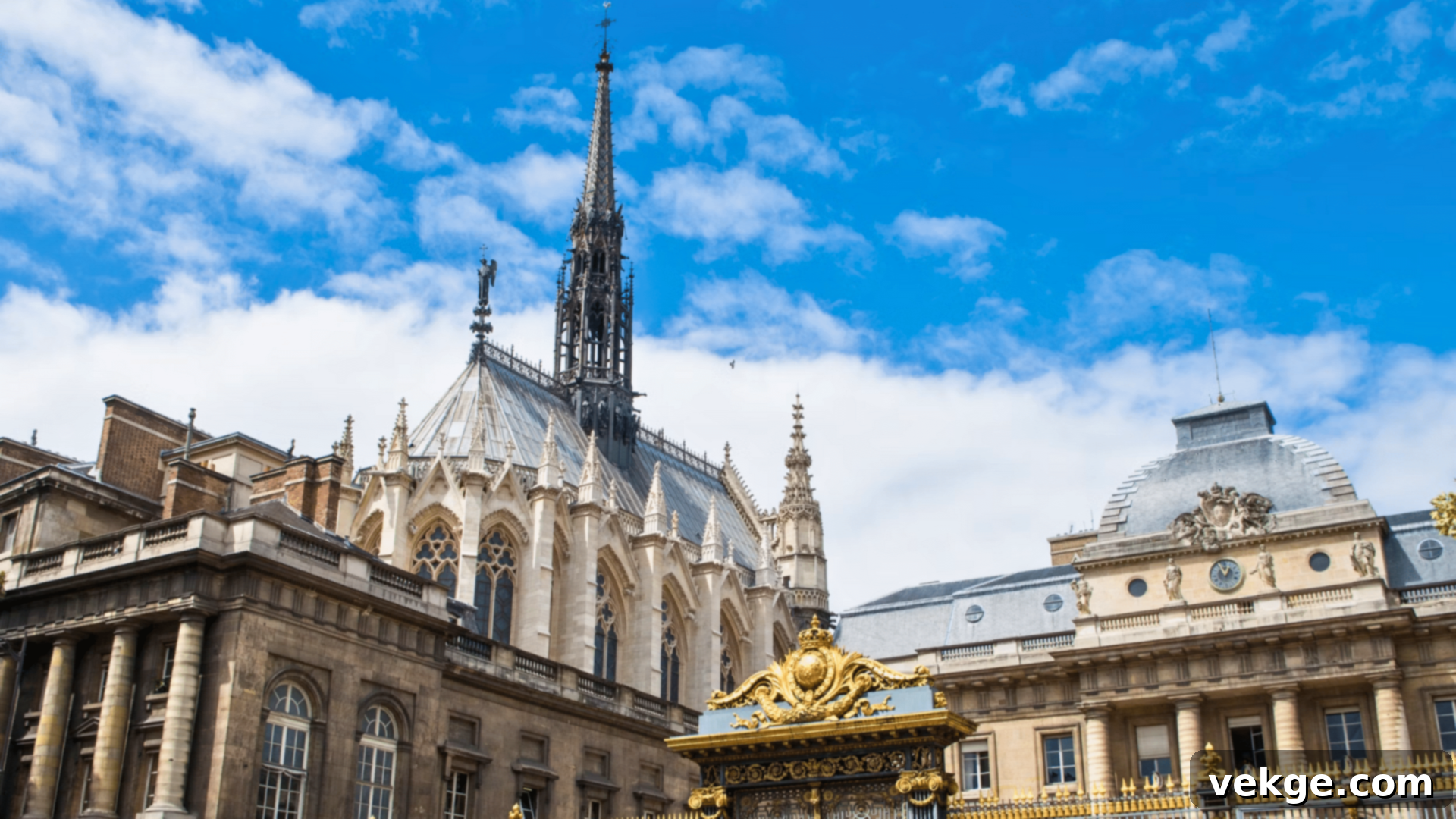
King Louis IX, later canonized as Saint Louis, commissioned the construction of Sainte-Chapelle in 1238. Its primary purpose was to serve as a magnificent reliquary, housing his collection of precious Christian relics, most notably Christ’s Crown of Thorns, which he acquired for a sum that significantly exceeded the cost of building the chapel itself. This demonstrated the immense spiritual and political importance of the relics.
Completed in an astonishingly short period of just seven years—an exceptionally rapid timeline for medieval construction—Sainte-Chapelle represents the zenith of Rayonnant Gothic architecture. This style emphasizes slenderness, intricate tracery, and, most remarkably, an unprecedented amount of stained glass.
The upper chapel is truly awe-inspiring, featuring 15 towering windows, each measuring 15 meters (49 feet) high. These immense windows create walls that are an astounding 70% glass, achieving the highest ratio of glass to stone of any medieval building. The 1,113 exquisitely detailed scenes depicted in the vibrant stained glass narrate biblical stories, spanning from Genesis to Christ’s resurrection, transforming the interior into a kaleidoscopic tapestry of light and color. Though it suffered damage during the French Revolution, it was meticulously repaired in the 19th century. A modern restoration, completed in 2015, utilized advanced laser technology to meticulously clean centuries of grime from the fragile glass, ensuring its brilliance for future generations.
12. Pont Neuf: Paris’s Enduring Old New Bridge

Paradoxically named “New Bridge,” Pont Neuf holds the distinguished title of Paris’s oldest standing bridge, a testament to its innovative design and robust construction. Completed in 1607 during the reign of Henri IV, it was revolutionary for its time in several groundbreaking aspects. It was the first Parisian bridge to be constructed entirely of stone without houses built upon it; previous bridges were lined with structures that frequently suffered from destructive fires.
Furthermore, it was the first bridge in the city to incorporate dedicated sidewalks, providing pedestrians with a safe passage, shielding them from the mud and horse traffic that plagued earlier bridges. Most significantly, Pont Neuf was the first bridge to span the entire width of the Seine River, effectively connecting both banks of the city via the Île de la Cité, a crucial link in Paris’s urban development.
The bridge is adorned with 381 captivating mascarons—stone masks featuring comical or grotesque faces, believed to represent various forest and river deities, adding a whimsical touch to its sturdy structure. Despite its protracted construction, which lasted an arduous 30 years due to numerous wars and funding challenges, the Pont Neuf quickly became a powerful symbol of Paris’s modernization and a lasting tribute to Henri IV’s visionary urban planning and commitment to public works.
13. Panthéon: A Temple of French National Heroes

Originally commissioned by King Louis XV as a grand church dedicated to Saint Genevieve, the revered patron saint of Paris, following his miraculous recovery from a serious illness. The esteemed designer Jacques-Germain Soufflot began its construction in 1757, envisioning a magnificent structure that skillfully blended classical and Gothic architectural elements, a truly innovative approach for its era.
However, the course of history dramatically altered its destiny. During the fervent years of the French Revolution, the National Assembly transformed the unfinished church into a secular mausoleum for French heroes in 1791, renaming it the Panthéon. Throughout the tumultuous political changes that followed, the building repeatedly switched between religious and secular purposes, reflecting the shifting tides of French national identity.
Today, its solemn crypt serves as the final resting place for 78 of France’s most celebrated citizens, an assembly of intellects, artists, and political figures including Voltaire, Rousseau, Victor Hugo, Émile Zola, Marie Curie, Alexandre Dumas, and Simone Veil. In 1851, the pioneering physicist Léon Foucault conducted his famous experiment within its dome, using a 67-meter (220-foot) pendulum to brilliantly demonstrate the Earth’s rotation, a replica of which still captivates visitors there today, merging science with history.
14. Les Invalides: A Home for Heroes
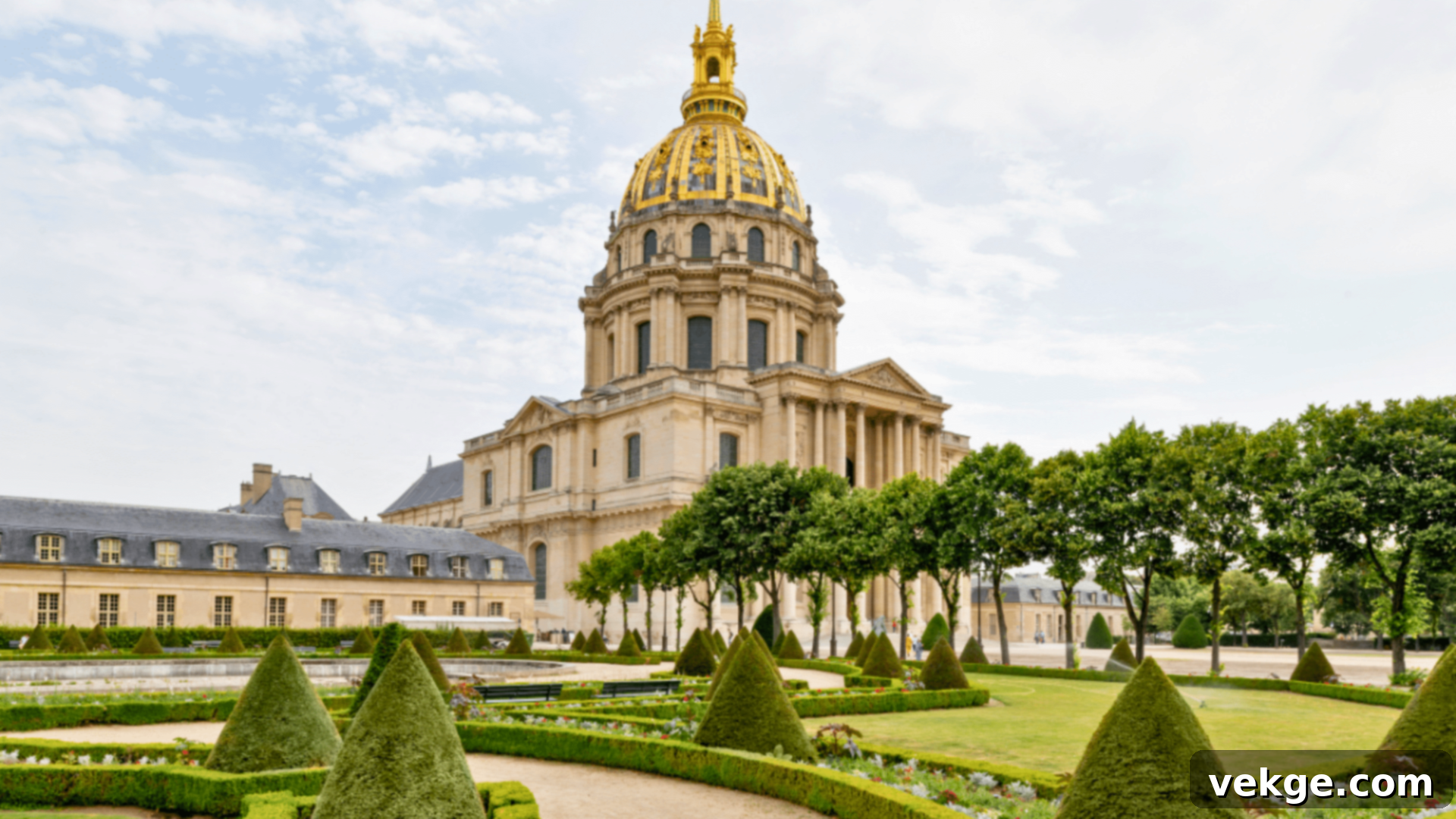
In a compassionate act of foresight and gratitude, King Louis XIV ordered the construction of Les Invalides in 1670. His vision was to establish a comprehensive complex that would provide housing, care, and medical attention for up to 4,000 war veterans, fulfilling his solemn promise “that those who devoted their lives to defending France should never worry about their sustenance.”
The vast site encompasses a state-of-the-art hospital, a dedicated retirement facility for soldiers, and multiple renowned museums, including the Musée de l’Armée (Army Museum), one of the largest military history museums in the world. Its magnificent Church of Saint-Louis proudly displays 28 flags captured from enemy armies, serving as a powerful symbol of French military achievements.
Les Invalides gained its most enduring fame when the remains of Emperor Napoleon Bonaparte were repatriated from Saint Helena in 1840. He was subsequently entombed with immense ceremony beneath the iconic golden dome of the Église du Dôme, resting in a massive sarcophagus crafted from red quartzite, set upon a striking green granite base. His resting place is a remarkable series of six nested coffins, made of tin, mahogany, two layers of lead, ebony, and oak, symbolizing his imperial stature. The military museum within the complex showcases an astounding 500,000 artifacts, ranging from historical weapons and intricate armor to military art, spanning from the Middle Ages through World War II, offering a profound journey through centuries of French military history.
15. Château de Chenonceau: The Ladies’ Castle

Affectionately known as the “Ladies’ Castle,” Château de Chenonceau boasts a history uniquely and profoundly intertwined with a succession of powerful and influential women. While Thomas Bohier began its construction in 1513, it was his wife, Katherine Briçonnet, who largely oversaw and directed the majority of its initial building phase, leaving her indelible mark on its design.
After the crown seized the château due to unpaid debts, King Henri II gifted it to his beloved mistress, Diane de Poitiers. Diane, with her impeccable taste, added the distinctive arched bridge that gracefully spans the tranquil River Cher, a feature that would become one of Chenonceau’s most iconic elements. Following Henri’s untimely death, his formidable widow, Catherine de Medici, compelled Diane to exchange Chenonceau for another property. Catherine then embarked on her own ambitious building projects, adding the famous two-story gallery atop Diane’s bridge, transforming it into a magnificent ballroom.
Later, during the chaotic French Revolution, Louise Dupin courageously saved the château from destruction by passionately arguing for its critical importance as the sole bridge across the Cher River for many miles, a vital artery for local transportation. During World War I, it served honorably as a military hospital. In World War II, the gallery spanning the river gained a new strategic significance, marking the boundary between Nazi-occupied territory and free France, making it a crucial, clandestine escape route for countless resistance fighters, imbuing it with a legacy of courage and humanitarian aid.
The Enduring Historical Importance of France’s Monuments
When you stand before these magnificent French landmarks, you’re doing more than simply admiring ancient architecture; you are connecting with the very pulse of history that has profoundly shaped a nation. Each monument serves as a powerful testament, a tangible narrative of France’s evolution, its triumphs, its struggles, and its enduring spirit.
From the formidable castles that once symbolized absolute royal power and strategic defense, to the soaring cathedrals and serene chapels that embody centuries of faith and artistic devotion, these structures tell a collective story. They speak of the rise and fall of empires, the fervent passion of revolutions, the quiet determination of everyday lives, and the monumental achievements of human ingenuity.
These sites have witnessed pivotal moments: peace treaties that redrew maps, wars that forged national identity, artistic movements that defined eras, and scientific breakthroughs that changed the world. They offer invaluable insights into the social structures, political ideologies, and cultural values that have ebbed and flowed through the centuries. They reflect how people lived, ruled, fought, innovated, and healed, providing a continuous thread linking the past to the present.
Today, these monuments stand not just as historical relics but as living symbols. They continue to educate, inspire, and remind us of the incredible human capacity for creation, resilience, and transformation. Visiting or learning about them offers a unique opportunity to immerse oneself in the rich narrative of France, fostering a deeper understanding of its origins, its enduring cultural legacy, and its profound impact on the global stage. They are the guardians of memory, ensuring that the lessons and glories of yesterday continue to resonate with meaning today.
Conclusion: A Timeless Journey Through French Heritage
Our journey through France’s most iconic monuments has revealed a captivating tapestry of history, culture, and human achievement. Each site, from the engineering marvel of the Eiffel Tower to the ancient grandeur of the Pont du Gard, and the sacred beauty of Sainte-Chapelle, possesses its own unique narrative, meticulously crafted by the hands of time, significant figures, and profound historical events.
We’ve traversed through the hallowed halls of churches, the formidable walls of castles, the enduring spans of bridges, and the treasure-filled galleries of museums. Each step of the way, these landmarks have offered distinct insights and shared their compelling stories, proving that you don’t need extensive historical expertise, but merely an open mind and a touch of curiosity, to appreciate their immense significance.
Our goal was to provide you with clear, engaging, and accurate information that is both easy to absorb and deeply enriching. If you embarked on this reading seeking to understand the enduring allure of French landmarks and their profound historical importance, we sincerely hope this guide has fulfilled that quest.
You now possess a more comprehensive understanding of how these architectural wonders are intimately connected to the nation’s illustrious past and why they continue to be cherished and celebrated by millions across the globe today. May this exploration inspire your own future discoveries and deepen your appreciation for the timeless beauty and indelible legacy of France.
